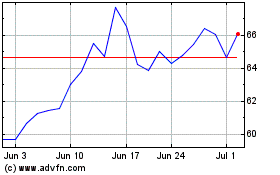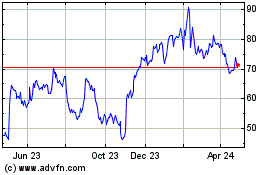Shopify's Business Sells Itself, for Now -- Heard on the Street
July 29 2020 - 1:11PM
Dow Jones News
By Laura Forman
Overall U.S. retail sales were down in the second quarter,
according to Census Bureau data. You would never know it from
Shopify's results.
With the pandemic forcing store closures world-wide, e-commerce
business is booming. Companies rushed to Shopify's online retail
platform in the early months of the pandemic, driving eye-popping
quarterly results for a company that was already growing at an
impressive clip.
Second-quarter revenue was up 97% from a year earlier to $714
million -- roughly 40% higher than Wall Street's expectations.
Meanwhile, gross merchandise volume topped $30 billion, well above
analysts' forecast of $19.9 billion and up 119% versus a year ago.
That growth looks all the more impressive when compared with the
26% growth in gross merchandise volume eBay reported Tuesday
evening. Shopify shares were up around 10% on Wednesday.
The company says its e-commerce platform is built to enable
businesses of all sizes "to sell to anyone, anywhere." As the
pandemic rages on, that value proposition has apparently been
selling itself. Shopify managed to turn a slight operating profit,
despite analysts' expectation for a loss, driven not only by
top-line outperformance but also by lower sales and marketing costs
versus Street expectations.
There were more incentives for business to come online this year
than just the pandemic. Shopify said it recently extended its trial
period for new standard plans from 14 to 90 days. That offer, which
ended May 31, was very popular. The company said new stores created
on its platform, or those who have provided billing information but
for which the company doesn't yet collect a subscription fee, grew
71% in the second quarter versus the same period last year.
But is that kind of growth sustainable? Shopify is now a $127
billion market-cap company whose share price has risen roughly 70%
over the past three months alone. And while the pandemic appears to
be far from over, it could be that the initial rush online is
moderating.
In its earnings release, Shopify said data from June 15 to July
19 shows new stores created during its extended free trial were
converting to paid subscriptions "at a slightly lower rate" than
merchants who joined the platform before the pandemic. It also
suggested more recent customers may be less established and
therefore less valuable to its top line.
The company declined to provide a formal third-quarter outlook,
citing both the unknown future impact of the pandemic and the
greater likelihood of an extended global recession.
Shopify says it now has nearly 6% of U.S. e-commerce sales --
more than eBay, Walmart, and Apple, but significantly lower than
Amazon.com's 37%. That highlights the upside opportunity for the
platform to continue to grow and take share, especially given its
wide range of subscription packages, priced anywhere from $29 to
over $2,000 a month. Still, with shares trading at all-time highs,
some correction seems likely, particularly if growth eases in the
third quarter.
"The world is changing fast," Shopify's chief executive said in
the company's earnings release. The question is whether Shopify's
market value can continue to rise as quickly.
Write to Laura Forman at laura.forman@wsj.com
(END) Dow Jones Newswires
July 29, 2020 12:56 ET (16:56 GMT)
Copyright (c) 2020 Dow Jones & Company, Inc.
Shopify (NYSE:SHOP)
Historical Stock Chart
From Mar 2024 to Apr 2024

Shopify (NYSE:SHOP)
Historical Stock Chart
From Apr 2023 to Apr 2024
